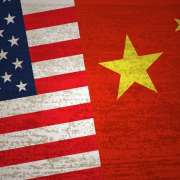
Nearing an Inflection Point: Preparing for a Change in Global Growth Velocity
- We have been downbeat on the global economic outlook, primarily due to our views on US-China trade frictions. Prior to the trade truce in Osaka, we established our base case in which the US imposes 25% tariffs on all Chinese imports and China retaliates before the end of the year. We stand by this forecast as tariff threats continue to escalate.
- The downside scenario to growth would entail the US and China following through their tariff threats. Other hotspots could boil over too, such as Brexit, Italy, Iran and Hong Kong.
- In the upside scenario to growth, geopolitical risks would subside and the two countries would quickly reach a trade truce, with other countries’ economies also rebounding strongly.
We have been downbeat on the global economic outlook, primarily due to our views on US-China trade frictions. Prior to the trade truce in Osaka, we established our base case in which the US imposes 25% tariffs on all Chinese imports and China retaliates before the end of the year. We stand by this forecast as tariff threats continue to escalate.
With the ongoing slowdown in global growth, rising business uncertainty and a tightening of financial conditions, our forecasts have been adjusted. In the US, we have trimmed our near-term GDP forecast and added a 25bp Fed rate cut in October to the 25bp cut in September. In Europe, we have lowered our 2019 GDP growth forecast to 1.0%. We have also further cut our 2019 GDP growth forecast for Australia and expect all Asia’s central banks (except Japan) to cut rates further this year. Our growth forecasts have not changed for China.
In this report, we paint a picture of what would happen if global growth soon hits an inflection point. There are two potential scenarios.
Downside scenario to growth
In this scenario, the ongoing growth slowdown and escalating trade tensions start to have non-linear effects via feedback loops between slowing growth and tightening financial conditions, spillover effects to services and consumption and amplifiers such as corporate stress. Additionally, the US could experience a mini recession, while the Fed would cut rates to near 0% and restart unconventional policies.
The downside could be exacerbated by some of the other hotspots boiling over, such as Brexit, Italy, Iran and Hong Kong. Germany’s economy would be hit hard, dragging Europe into a technical recession and leaving the region very exposed to a hard Brexit or a debt crisis in Italy. In the UK, if a hard Brexit occurs, the BOE could cut rates despite sharply rising inflation. Finally, Asia’s open economies, such as Hong Kong, Singapore, South Korea, Thailand and Malaysia, face large GDP contractions.
Upside scenario to growth
Under this scenario, the geopolitical risks subside, and the US and China quickly reach a trade truce, such that their tariff threats are not realized. Here, the Fed may only cut once more in September, and start hiking in late 2020. In China, with the 6.0-6.5% GDP growth target easily achievable, policy makers’ focus would return to reducing financial stability risks, avoiding another property bubble. Germany and other Asian economies would rebound strongly, led by exports and investment.
For a breakdown of each country’s upside and downside growth scenarios, read our full report here.
Contributor

Rob Subbaraman
Head of Global Macro Research

Lewis Alexander
Chief US Economist

Ting Lu
Chief China Economist

George Buckley
Chief UK & Euro Area Economist

Takashi Miwa
Chief Japan Economist

Sonal Varma
Chief Economist, India and Asia ex-Japan
Disclaimer
This content has been prepared by Nomura solely for information purposes, and is not an offer to buy or sell or provide (as the case may be) or a solicitation of an offer to buy or sell or enter into any agreement with respect to any security, product, service (including but not limited to investment advisory services) or investment. The opinions expressed in the content do not constitute investment advice and independent advice should be sought where appropriate.The content contains general information only and does not take into account the individual objectives, financial situation or needs of a person. All information, opinions and estimates expressed in the content are current as of the date of publication, are subject to change without notice, and may become outdated over time. To the extent that any materials or investment services on or referred to in the content are construed to be regulated activities under the local laws of any jurisdiction and are made available to persons resident in such jurisdiction, they shall only be made available through appropriately licenced Nomura entities in that jurisdiction or otherwise through Nomura entities that are exempt from applicable licensing and regulatory requirements in that jurisdiction. For more information please go to https://www.nomuraholdings.com/policy/terms.html.



